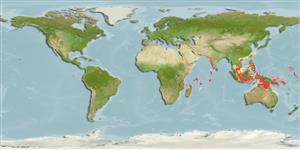Teleostei (teleosts) >
Anguilliformes (Eels and morays) >
Ophichthidae (Snake eels) > Myrophinae
Etymology: Skythrenchelys: Name from Greek 'skythros' for angry or sullen and 'enchelys' for an eel, referring to the facial expression of the included species. Treated as feminine according to Opinion 95 of the Bulletin of Zoological Nomenclature, 1970; zabra: Named in reference to its ability to ingest very large prey.
More on authors: Castle & McCosker.
Environment: milieu / climate zone / depth range / distribution range
Ecology
Marine; brackish; demersal; depth range 1 - 180 m (Ref. 40863). Tropical
Indo-West Pacific: India, Straits of Malacca, Philippines, Indonesia, and northern Australia.
Size / Weight / Age
Maturity: Lm ? range ? - ? cm
Max length : 29.6 cm TL male/unsexed; (Ref. 40863)
Short description
Identification keys | Morphology | Morphometrics
Dorsal soft rays (total): 217 - 250; Anal soft rays: 127 - 165; Vertebrae: 112 - 122. Tail 43-46% of TL; dorsal fin arising in mid-trunk; supraorbital pores 1+ 4, infraorbital pores 4 + 1, preoperculomandibular pores 6 + 2 or 3, supratemporal pores 2; uniform tan in color. Remarks: pectorals scarcely visible; caudal fin short.
Most specimens collected from a shallow turbid estuary.
Life cycle and mating behavior
Maturity | Reproduction | Spawning | Eggs | Fecundity | Larvae
Castle, P.H.J. and J.E. McCosker, 1999. A new genus and two new species of myrophine worm-eels, with comments on Muraenichthys and Scolecenchelys (Anguilliformes: Ophicthidae). Rec. Aust. Mus. 51(2-3):113-122. (Ref. 40863)
IUCN Red List Status (Ref. 130435: Version 2024-2)
Threat to humans
Harmless
Human uses
Tools
Special reports
Download XML
Internet sources
Estimates based on models
Preferred temperature (Ref.
123201): 25.9 - 28.9, mean 27.8 °C (based on 682 cells).
Phylogenetic diversity index (Ref.
82804): PD
50 = 0.7500 [Uniqueness, from 0.5 = low to 2.0 = high].
Bayesian length-weight: a=0.00076 (0.00029 - 0.00197), b=3.06 (2.83 - 3.29), in cm total length, based on LWR estimates for this (Sub)family-body shape (Ref.
93245).
Trophic level (Ref.
69278): 4.0 ±0.7 se; based on size and trophs of closest relatives
Resilience (Ref.
120179): High, minimum population doubling time less than 15 months (Preliminary K or Fecundity.).
Fishing Vulnerability (Ref.
59153): Low vulnerability (20 of 100).
